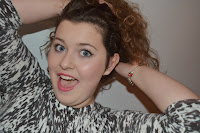Ally
Child,
one of the UK’s biggest pop stars of today, now speaks the truth on why people
perceive her to be the ‘Wild Child’ of the pop industry in a tell-all interview
exclusive with Popaholic...
Ally
Child has been repeatedly been slammed in the press for behaving so
outrageously recently. So our journalists have swooped in to take action! We
want to get to the truth, so Rosie from the Popaholic team interviewed Ally
Child to find out what is really going on…
Rosie– Hi Ally! Really nice to finally meet you!
Ally– Hey!
Rosie– So, let
me just ask you first of all, are you really a ‘wild child’?
Ally– Well…
It’s sort of my nature. I can’t help having fun!
Rosie– And do
you get irritated by some of the stories made about you nowadays?
Ally– Not
really! You know, my motto in life is Live, Laugh and Have fun!
Rosie– So your
behaviour recently has nothing to do with gaining media attention?
Ally– No not
at all! I don't care about that stuff. As I said, I just live for now and have
fun.
Rosie– But
sometimes, do you admit it can get out of hand?
Ally-
(laughs) well, yes... there has been a few times.
Rosie– Lets
talk about the time you jumped off stage and broke a girls arm! Was that fun?
Ally– Oh gosh
(laughs) I knew you’d bring that up!
Rosie– Well?
Ally– Obviously
I didn't intend to break someone's arm! I was just messing about, and it just
sort of
happened. Looking back, it was totally silly and of course I regret it.
Rosie– Lets
talk about your new album, what can we expect from it?
Ally– You can
expect a lot of fun, edgy pop music tracks. My favourite thing to do is record
tracks. There's nothing better...other than chocolate of course! (laughs)
Rosie– That
sounds great. So are all the songs
written by you?
Ally– Yeh
they sure are! I know people might think I’m wild and the only thing I do is
party… but there is a serious side to me and when I get into my music, there’s
no stopping me!
Rosie– And is
there a romance on the cards any time soon?
Ally– Well
only time can tell, you just don't know what’s around the corner.
Rosie– Would
you like to explain these rumours about yourself and Martin Cliffshaw then?
Ally– There’s
nothing I can tell you really, we are really good friends who like spending
time with each other, is there harm in that! And I am certainly allowed a
personal life!
Rosie– Yes you
are! Well I wish you all the best with your upcoming album and with your pop
career in the future!
Ally– Thanks!
Rosie– And
thanks for coming to meet with me, it’s been fun!
Ally– Yeh,
any time!



 This is the photo I chose to use on the front cover.
This is the photo I chose to use on the front cover.